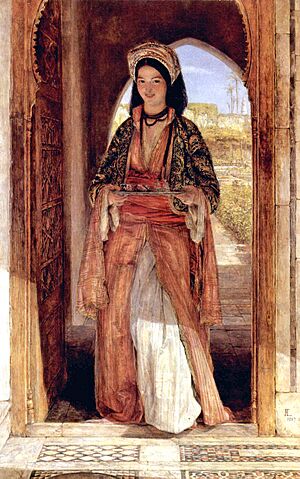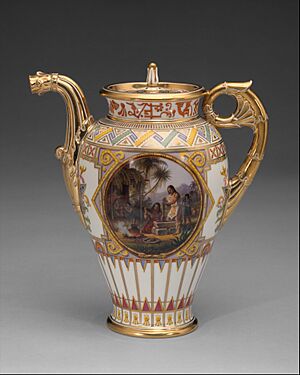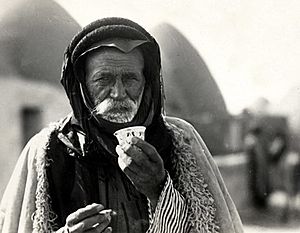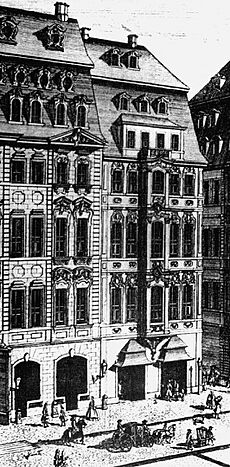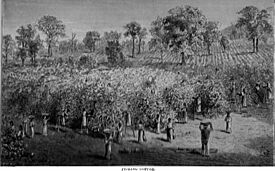History of coffee facts for kids
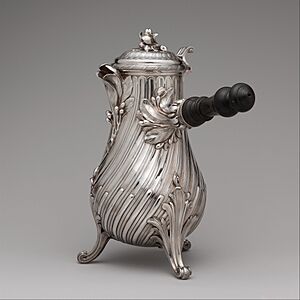
The history of coffee goes back many centuries to Ethiopia and Yemen. People in Mecca already knew about coffee in the 1400s. Around the same time, Sufi monasteries in Yemen used coffee to help them focus during prayers.
Coffee later spread to the Levant (the eastern Mediterranean area) in the early 1500s. It caused some arguments about whether it was allowed (called halal) in the Ottoman and Mamluk societies. Coffee reached Italy in the late 1500s through trade routes across the Mediterranean Sea. People in Central and Eastern Europe learned about coffee from the Ottomans. By the mid-1600s, coffee had arrived in India and the East Indies.
Coffee houses started appearing in Western Europe by the late 1600s, especially in Holland, England, and Germany. One of the first times coffee was grown in the New World was when Gabriel de Clieu brought coffee seedlings to Martinique in 1720. These plants grew into 18,680 coffee trees. This helped coffee spread to other Caribbean islands like Saint-Domingue and also to Mexico. By 1788, Saint-Domingue was providing half of the world's coffee.
By 1852, Brazil became the world's biggest coffee producer. It has kept that title ever since. After 1950, more countries started producing a lot of coffee. These included Colombia, Ivory Coast, Ethiopia, and Vietnam. Vietnam even became the second-largest producer in 1999. Today, modern ways of making coffee and selling it everywhere have made it a common drink in many homes.
Contents
What's in a Name?
The word coffee came into the English language in 1582. It came from the Dutch word koffie. This word was borrowed from the Ottoman Turkish kahve. That word, in turn, came from the Arabic word qahwah.
Old Arab lexicographers (people who write dictionaries) thought qahwah meant 'wine'. This was because of its dark color. It might have come from the verb qahiya, meaning 'to have no appetite'. However, qahwah most likely meant 'the dark one', referring to the drink or the bean. Some languages in the Semitic family have a root qhh, meaning "dark color." This made it a natural name for the drink.
Another word for 'coffee' is buna, bun, būn, or buni. This word is common in languages of Ethiopia. It is often thought to come from the Arabic word bunn, which means 'coffee bean'. But it might also come from Cushitic languages.
The terms coffee pot and coffee break were first used in 1705 and 1952.
Coffee's Family Tree
Scientists have studied the genetic diversity of Coffea arabica plants. They found that these plants don't have a lot of genetic variety. But they do have some traits from their older relatives. Scientists also looked at related plants like Coffea canephora and C. liberica.
However, there is no clear proof of where in Africa coffee first grew. We also don't know who among the local people might have used it as a stimulant. The first coffee plant grown by people is thought to be from Harar. The wild coffee plants are believed to have come from Ethiopia. There are also similar groups of plants nearby in Sudan and Kenya.
How Coffee Spread

One of the first mentions of coffee was by the Persian doctor Muhammad ibn Zakariya al-Razi in the 900s. He wrote about something called bunchum. More certain information about the coffee tree and how to make a drink from its roasted berries comes from the late 1400s.
A Sufi Imam named Muhammad Ibn Said al-Dhabhani brought goods from Ethiopia to Yemen. Somali merchants from Berbera and Zeila first exported coffee from Ethiopia to Yemen. They got the coffee from Harar and the Ethiopian interior.
An important early writer about coffee was Abd al-Qadir al-Jaziri. In 1587, he wrote a book about the history of coffee. He explained how coffee spread from Arabia Felix (now Yemen) north to Mecca and Medina. Then it went to bigger cities like Cairo, Damascus, Baghdad, and Constantinople. He said that a Sheikh named Jamal-al-Din al-Dhabhani (who died in 1470) was the first to use coffee around 1454.
He found that among its properties was that it drove away fatigue and lethargy, and brought to the body a certain sprightliness and vigour.
Al-Jaziri's book was also important for coffee's history in Europe. A copy reached the French royal library. Parts of it were translated by Antoine Galland in 1699.
Coffee in the Middle East
Sufis in Yemen used coffee to help them stay focused. They drank it to stay awake during their prayers at night. By 1414, people in Mecca knew about the plant. In the early 1500s, it spread to the Mamluk Sultanate of Egypt and North Africa. It came from the Yemeni port of Mocha.
Many coffee houses, linked to Sufism, opened in Cairo, Egypt. They were often near the religious University of the Azhar. These coffee houses also opened in Syria, especially in the city of Aleppo. Then, in 1554, they appeared in Istanbul, the capital of the Ottoman Empire. The German doctor and botanist Leonhard Rauwolf was the first European to mention coffee. He saw it in Aleppo in 1573 and called it chaube. Other European travelers soon wrote about it too.
In 1511, some strict religious leaders in Mecca banned coffee. They didn't like its stimulating effect. However, these bans were later overturned in 1524 by Ottoman Turkish Sultan Suleiman I. The Grand Mufti Mehmet Ebussuud el-İmadi issued a religious ruling (a fatwa) that allowed people to drink coffee. In Cairo, a similar ban happened in 1532. Coffeehouses and places storing coffee beans were attacked.
During the 1500s, coffee had already reached the rest of the Middle East, the Safavid Empire, and the Ottoman Empire. From the Middle East, coffee drinking spread to Italy, then to the rest of Europe. The Dutch also took coffee plants to the East Indies and the Americas.
Coffee in Ethiopia
The Ethiopian Orthodox Church banned coffee sometime before the 1700s. But in the late 1800s, Ethiopians became more open to drinking coffee. Its use spread quickly between 1880 and 1886. This was mainly because Emperor Menelik drank it himself. Also, Abuna Matewos helped convince the clergy that it was not just a Muslim drink.
Coffee and Islam
Early Islamic doctors and scientists argued that coffee was not like alcohol. They said it helped the mind. Coffeehouses in Mecca, Yemen, and Cairo became very popular. They became important places for public life in the Islamic Empires. These coffeehouses sometimes acted like learning centers, similar to the bayt al-Hakima or madrasas.
Neha Verami from the Folger Shakespeare Library said that these coffeehouses showed three things. First, they were places where people could discuss ideas. Second, more people could take part in the political life of the early Islamic empires. Third, it showed that Western ideas about "Oriental" societies being ruled by dictators were not always true. Coffee became a deep part of Islamic culture for centuries.
However, coffee did cause some debate. When the fatwa (religious ruling) came out in 1532–1533, coffee was declared forbidden (haram). This was likely because, like alcohol, coffee affected how people thought, even if it was a milder effect. Drinking coffee in public was also frowned upon.
Leaders tried to stop coffee from becoming too popular. Sultan Suleiman I put taxes on coffee to stop government workers and unemployed people from drinking it. Later, during the reigns of Sultan Selim II (1567) and Sultan Murad III (1583), more attempts were made to control coffee. This happened when common people like craftsmen and soldiers started drinking it.
In the Ottoman Empire, shops called taḥmīskhāne roasted and crushed coffee beans using traditional methods. Coffee houses in places like Mecca were visited by all kinds of people. These included Muslims from mosques, traders, and travelers.
Despite the arguments, coffee was very important to the economy around the Red Sea. This was true from the mid-1400s to the mid-1600s. In the past, the Oromo tribe in Ethiopia made foods from coffee plants. One was bunna qela, made with butter, salt, and roasted beans. This was a basic recipe that changed over time. A more modern drink called qishr in Arabic is made from dried coffee cherry skins. These skins would normally be thrown away after making the drink buna. Instead, they are used to brew a kind of fruit tea. Qishr (or cascara in Spanish) is still sold by coffee farmers today.
Old Stories of Coffee
There are several old stories about how coffee was discovered. One legend says that the ancestors of today's Kafficho people in the Kingdom of Kaffa were the first to notice coffee's energizing effect.
One story tells of a goatherd named Kaldi in Ethiopia in the 800s. He saw his goats become very lively after eating bright red berries from a bush. Kaldi tried the berries himself and felt excited. He took the berries to a monk in a nearby monastery. But the monk didn't like them and threw them into a fire. An amazing smell came from the fire, making other monks curious. They quickly raked the roasted beans from the embers, ground them up, and mixed them with hot water. This, the story says, was the world's first cup of coffee. This story didn't appear in writing until 1671, 800 years after it supposedly happened. So, it's probably not true.
Another story is about a Moroccan Sufi mystic named Ghothul Akbar Nooruddin Abu al-Hasan al-Shadhili in the 1200s. The legend says that while traveling in Ethiopia, he saw very lively birds eating berries. When he tried the berries, he felt the same energy.
Yet another story gives credit for coffee's discovery to Omar, a student of Sheikh Abu al-Hasan ash-Shadhili. An old record says that Omar, who was known for healing the sick with prayer, was once sent away from Mecca to a desert cave. Starving, Omar chewed berries from a nearby bush, but they were too bitter. He tried roasting them to make them taste better, but they became too hard. Then he tried boiling them to soften them. This made a fragrant brown liquid. After drinking it, Omar felt much better and survived for days. When stories of this "miracle drug" reached Mecca, Omar was asked to return and later became a saint.
Coffee was first used in the Islamic world and was linked to religious practices. For example, coffee helped Muslims fast during the day and stay awake at night during the celebration of Ramadan.
It [coffee] became associated with Muhammad's birthday. Indeed, various legends ascribed coffee's origins to Muhammad, who, through the archangel Gabriel, brought it to man to replace the wine which Islam forbade.
Coffee Comes to Europe
Coffee first arrived in Europe in Hungary when the Turks invaded in 1526. Within a year, coffee reached Vienna with the same Turks who fought at the Siege of Vienna (1529). Later in the 1500s, coffee came to the island of Malta through slavery. Turkish Muslim slaves, captured by the Knights of St John in 1565, made their traditional coffee drink. Domenico Magri wrote that "Turks, most skillful makers of this concoction." Coffee became popular in Maltese high society, and many coffee shops opened.
The first time coffee was mentioned in a European book was in 1575. The author learned about it from someone in Padua, Italy. Englishmen traveling through the Safavid and Ottoman Empires in the late 1500s noted that coffee was "very good to help digestion, to quicken the spirits, and to cleanse the blood.”
Trade between the Republic of Venice and North Africa, Egypt, and the East brought many goods, including coffee, to Venice. Venetian merchants introduced coffee to wealthy people in Venice, charging a lot for it. This is how coffee came to mainland Europe. In 1591, Venetian botanist Prospero Alpini was the first to write about the coffee plant in Europe. The first European coffee house (outside the Ottoman Empire and Malta) opened in Venice in 1645.
Coffee traveled to Europe in two main ways. First, through the large Ottoman Empire, which allowed goods like coffee to reach Europe. Second, from the port of Mocha in Yemen, where the East India Trading Co. bought large amounts of coffee and brought it back to Europe. Coffee became a very important part of culture in most of Europe. Kings, queens, and common people all loved the drink. The way coffee came to the Western world is much like how scientific knowledge from Islamic Empires spread.
Coffee in Austria
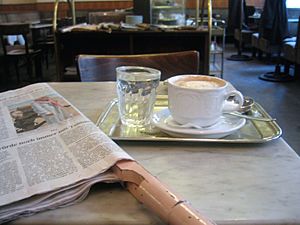
The first coffeehouse in Austria opened in Vienna in 1683. This was after the Battle of Vienna, and they used coffee beans taken from the defeated Turks. A Polish military officer named Jerzy Franciszek Kulczycki opened the coffee house. He helped make it popular to add sugar and milk to coffee. Melange is a typical Viennese coffee. It comes with hot foamed milk and is usually served with a glass of water.
A special Viennese coffee house culture grew in Vienna in the 1800s. It then spread across Central Europe. Scientists, artists, thinkers, and wealthy people met in these Viennese coffee houses. Famous people like Gustav Klimt, Sigmund Freud, James Joyce, and Egon Schiele found inspiration there. This diverse coffee house culture led to different ways of preparing coffee. For example, the world-famous cappuccino developed from the Viennese Kapuziner coffee.
Coffee in the United Kingdom
The first coffeehouse in England opened in St. Michael's Alley in Cornhill, London. The owner was Pasqua Rosée, a servant of Daniel Edwards, who traded Turkish goods. Edwards imported the coffee and helped Rosée start the shop. Coffee also came to England through the British East India Company and the Dutch East India Company in the 1600s. Oxford's Queen's Lane Coffee House, started in 1654, is still open today.
By 1675, there were over 3,000 coffeehouses across England. These early English coffee houses became places for serious talks about religion and politics. This was a rare chance for people to have calm discussions. This practice became so common that King Charles II tried to close coffee houses in the 1670s.
Women were not always allowed in coffeehouses in Europe, including England. However, in Germany, for example, women often visited them. Many people at this time thought coffee had healing powers. Famous doctors often suggested coffee for health problems and even as a cure for nervous conditions.
Coffee in France
Antoine Galland (1646–1715) wrote about how Muslims were connected to coffee, tea, and chocolate. He said, "We are indebted to these great [Arab] physicians for introducing coffee to the modern world through their writings, as well as sugar, tea, and chocolate." He was wrong about chocolate, though, as it came to Europe from the Americas through the Spanish. Galland reported that a Mr. Thevenot, who had traveled in the East, brought coffee to Paris in 1657. Thevenot gave some beans to his friends, including Mr. de la Croix, who was an interpreter for King Louis XIV.
In 1669, Soleiman Agha, an Ambassador from Sultan Mehmed IV, arrived in Paris with many coffee beans. They offered coffee to their French and European guests. They also gave some beans to the royal court. Between July 1669 and May 1670, the Ambassador helped make coffee drinking a popular custom among Parisians.
Coffee in Germany
In Germany, coffeehouses first opened in North Sea ports like Wuppertal-Ronsdorf (1673) and Hamburg (1677). At first, the new drink was called coffee, like in English. But in the 1700s, Germans started using the French word café. Then they slowly changed the spelling to Kaffee, which is what they use today. In the 18th century, coffee became more popular across Germany. Even the ruling classes started drinking it. Coffee was served at the court of Frederick William of Brandenburg as early as 1675. But Berlin's first public coffee house didn't open until 1721.
Composer Johann Sebastian Bach worked at St. Thomas Church in Leipzig from 1723 to 1750. He led a music group at the local Café Zimmermann. Sometime between 1732 and 1735, he wrote a fun piece called the "Coffee Cantata". In this musical story, a young woman named Lieschen begs her father to accept her love for coffee. The words include lines like:
Ei! wie schmeckt der Coffee süße,
Lieblicher als tausend Küsse,
Milder als Muskatenwein.
Coffee, Coffee muss ich haben,
Und wenn jemand mich will laben,
Ach, so schenkt mir Coffee ein!
(Oh! How sweet coffee does taste,
Better than a thousand kisses,
Milder than muscat wine.
Coffee, coffee, I've got to have it,
And if someone wants to perk me up,
Oh, just give me a cup of coffee!)
Coffee in Italy
In Italy, coffee arrived in the late 1500s through trade routes in the Mediterranean Sea. In 1580, the Venetian botanist and doctor Prospero Alpini brought coffee to the Republic of Venice from Egypt. Soon, coffee shops started opening. Coffee became the drink of thinkers, social gatherings, and even lovers. Plates of chocolate and coffee were seen as a romantic gift. By 1763, Venice alone had over 200 coffee shops. Many people praised the health benefits of this "miraculous drink."
Some Catholic Church leaders at first opposed coffee in Italy. They thought it was the "Devil's drink." But Pope Clement VIII, after trying the fragrant drink himself, gave it his blessing. This helped its popularity and sales grow even more. When he tasted coffee, Pope Clement VIII supposedly said, "Why, this Satan's drink is so delicious that it would be a pity to let the infidels have exclusive use of it." He may have blessed the bean because it seemed better for people than alcoholic drinks. The year often mentioned for this is 1600. It's not clear if this story is true, but it was probably seen as funny at the time.
In Turin, in 1933, Alfonso Bialetti invented the first moka pot. He got the idea from watching a steam pot used for laundry. In 1946, his son Renato started making them in factories. He sold millions of moka pots in one year. His father had only sold 70,000 in the previous 10 years. This made the moka pot (and coffee) a symbol of Italy around the world.
Naples, though famous for coffee today, got it later. It likely came through ships arriving in the ports of Sicily and Naples. Some say Naples discovered coffee in 1614. That's when the composer and explorer Pietro Della Valle sent news from the Holy Land to his friend, a doctor and poet. He wrote about a drink called kahve that Arab Muslims brewed in hot pots.
Some believe coffee arrived in Naples even earlier, from Salerno. There, the plant was used for its medicinal properties between the 1300s and 1400s. Coffee quickly became a big part of life in Naples. It was celebrated in art, literature, music, and daily social life. Neapolitans prepared it carefully in the "cuccumella," a special Neapolitan filter coffee pot. This pot came from an invention by a Parisian named Morize in 1819. Neapolitan craftspeople learned about it when it was brought to the Port of Naples by sea trade.
A good example of how Neapolitans see coffee as a social drink is the practice of "suspended coffee." This is when someone pays in advance for a coffee for the next customer. The Neapolitan philosopher Luciano De Crescenzo called it a coffee "given by an individual to mankind."
Coffee in the Netherlands
The Dutch were the first Europeans to get live coffee trees or beans in 1616. Pieter van den Broecke, a Dutch merchant, got some of the carefully guarded coffee bushes from Mocha, Yemen. He took them back to Amsterdam and planted them in the Botanical gardens, where they grew well. This event didn't get much attention, but it had a huge impact on coffee's history.
The beans van der Broecke got from Mocha grew well in the greenhouses at the Amsterdam Botanical Garden. They produced many healthy Coffea arabica bushes. In 1658, the Dutch used these plants to start growing coffee in Ceylon (now Sri Lanka) and later in southern India. They later stopped growing coffee there to focus on their plantations in Java. This was to avoid having too much coffee and lowering the price.
Within a few years, the Dutch colonies (Java in Asia, Suriname in the Americas) became the main suppliers of coffee to Europe.
Coffee in Poland
Coffee reached the Polish–Lithuanian Commonwealth in the 1600s. It mainly came through merchants trading with the nearby Ottoman Empire. The first coffee shops opened a century later. Coffee drinking has grown since the government changed in 1989. However, people in Poland still drink less coffee per person than in most European countries. During the Communist period, when many things were scarce, Poles made their own coffee substitute. It was called Inka and was made from roasted cereal.
Today, Poland is seeing a boom in coffee drinking. Many new cafes are opening, and new trends like specialty coffee are popular.
Coffee in the Americas
Gabriel de Clieu brought coffee seedlings to Martinique in the Caribbean in 1720. These plants grew well. Fifty years later, there were 18,680 coffee trees in Martinique. This helped coffee growing spread to Saint-Domingue (Haiti), Mexico, and other Caribbean islands. The French territory of Saint-Domingue started growing coffee in 1734. By 1788, it supplied half of the world's coffee.
Coffee had a big impact on the geography of Latin America. The French colonial plantations used many African slave laborers. The very difficult conditions for slaves on coffee plantations were a reason for the Haitian Revolution that soon followed. The coffee industry there never fully recovered.
Coffee also made its way to the Isle of Bourbon, now called Réunion, in the Indian Ocean. The plants there produced smaller beans. They were considered a different type of arabica called var. Bourbon. The Santos coffee from Brazil and the Oaxaca coffee from Mexico came from that Bourbon tree.
Around 1727, the King of Portugal sent Francisco de Melo Palheta to French Guiana. His mission was to get coffee seeds to join the coffee market. Francisco at first had trouble getting these seeds. But he charmed the French Governor's wife, and she sent him enough seeds and shoots to start Brazil's coffee industry. However, growing coffee didn't really take off until Brazil became independent in 1822. This led to large areas of the Atlantic Forest being cleared for coffee plantations. This happened first near Rio and later near São Paulo.
In 1893, coffee from Brazil was brought to Kenya and Tanzania (Tanganyika). This was not far from its original home in Ethiopia, 600 years earlier. This completed its journey across continents.
After the Boston Tea Party in 1773, many Americans started drinking coffee during the American Revolution. Drinking tea had become seen as unpatriotic.
Many countries started growing coffee in the late 1800s. In almost all of them, this involved moving and using local people on a large scale. Difficult conditions led to many uprisings and harsh crackdowns on farmers. For example, Guatemala started producing coffee in the 1500s. But it didn't have enough workers to harvest the coffee beans. So, the Guatemalan government forced local people to work on the fields. This caused tension between the local people and the Guatemalan government that still exists today.
A notable exception is Costa Rica. There, a lack of available workers stopped large farms from forming. Smaller farms and fairer conditions helped prevent unrest during the 1800s and 1900s.
In the 1900s, Latin American countries faced a possible economic crisis. Before World War II, Europe bought a lot of coffee. Once the war started, Latin America lost 40% of its market. It was close to economic collapse. Coffee was, and is, a major product for Latin America. The United States saw this and talked with the Latin American countries. As a result, the producers agreed to share the U.S. market fairly. The U.S. government watched over this agreement. While this plan was followed, the value of coffee doubled. This greatly helped coffee producers and Latin American countries.
Brazil became the world's largest coffee producer by 1852 and has been ever since. It controlled world production, exporting more coffee than all other countries combined, from 1850 to 1950. After 1950, more major producers emerged. These included Colombia, Ivory Coast, Ethiopia, and, most recently, Vietnam. Vietnam passed Colombia to become the second-largest producer in 1999. By 2011, Vietnam had 15% of the market.
A recent change in the coffee market is the popularity of lattes, Frappuccinos, and other sugary coffee drinks. This has allowed coffee houses to use cheaper coffee beans in their drinks.
Coffee in Asia
When coffee was first grown, brewed coffee was only for priests and doctors. Doctors used the drink for patients who needed better digestion. Priests used it to stay awake during their long nights of studying for the church.
Coffee in India
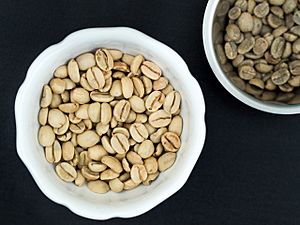
Coffee came to India before the East India Company. It was brought by an Indian Sufi saint named "Baba Budan." The first record of coffee growing in India is from 1670. This was after Baba Budan introduced coffee beans from Yemen to the hills of Chikmagalur, Karnataka. Since then, coffee farms have grown in the region, extending south to Kodagu.
Coffee production in India is mostly in the hill areas of South Indian states. Karnataka produces 53%, Kerala 28%, and Tamil Nadu 11% of the 8,200 Tonnes. Indian coffee is said to be the best coffee grown in the shade anywhere in the world. There are about 250,000 coffee growers in India. 98% of them are small growers. As of 2009, India's coffee production was only 4.5% of the world's total. Almost 80% of the country's coffee is exported. Of that, 70% goes to Germany, Russia, Spain, Belgium, Slovenia, the United States, Japan, Greece, the Netherlands, and France. Italy buys 29% of the exports. Most of the exported coffee is shipped through the Suez Canal.
Coffee is grown in three regions of India. Karnataka, Kerala, and Tamil Nadu are the traditional coffee-growing areas of South India. New areas have developed in Andhra Pradesh and Orissa on the eastern coast. A third region includes the states of Assam, Manipur, Meghalaya, Mizoram, Tripura, Nagaland, and Arunachal Pradesh in Northeastern India.
Indian coffee, mostly grown in southern India under monsoon rains, is also called "Indian monsooned coffee." Its flavor is described as: "The best Indian coffee tastes like Pacific coffees. But at its worst, it is simply plain and not exciting." The two main types of coffee grown are Arabica and Robusta. The first type introduced in the Baba Budan Giri hills of Karnataka in the 1600s was sold under the names Kent and S.795. Coffee is served in a special drip-style "filter coffee" across Southern India.
Chikmagalur Coffee
Coffee is very important to Chikmagalur's economy. Chikmagalur is where coffee first started in India, about 350 years ago. The Coffee Board is a government department in Chikmagalur town. It oversees coffee production and sales in the area.
Coffee is grown in Chikmagalur district on about 85,465 hectares. Arabica is the main type grown in the higher hills. Robusta is the main type in the lower hills. There are about 15,000 coffee growers in this district. 96% of them are small growers with farms of 4 hectares or less. The average production is 55,000 metric tons: 35,000 metric tons of Arabica and 20,000 metric tons of Robusta. The average amount produced per hectare is 810 kg for Arabica and 1110 kg for Robusta. These amounts are higher than the national average.
Arabica coffee is also known as the "coffee shrub of Arabia," "mountain coffee," or "arabica coffee." Coffea arabica is believed to be the first type of coffee grown by people. It has been grown in southwest Arabia for over 1,000 years. It is thought to produce better coffee than the other main type grown for sale, Coffea canephora (Robusta). Arabica has less caffeine than any other type of coffee grown for sale.
Robusta coffee comes from western Africa. It is mostly grown in Africa and Brazil, where it is often called Conillon. It is also grown in Southeast Asia, where French colonists brought it in the late 1800s. In recent years, Vietnam, which only produces Robusta, has passed Brazil, India, and Indonesia. It is now the world's single largest exporter of Robusta. About one-third of the coffee produced in the world is Robusta.
Coffee in Japan
The Dutch brought coffee to Japan in the 1600s. But it was just a curiosity until trade rules were relaxed in 1858. The first European-style coffeehouse opened in Tokyo in 1888. It closed four years later. By the early 1930s, there were over 30,000 coffeehouses across Japan. During wartime and right after, coffee was almost impossible to find. Then, it quickly became available again as import rules were removed. The introduction of freeze-dried instant coffee, canned coffee, and chains like Starbucks and Doutor Coffee in the late 1900s continued this trend. Now, Japan is one of the top countries for coffee drinking per person in the world.
Coffee in South Korea
Coffee's first famous Korean fans were 19th-century emperors Sunjong and Gojong. They liked to drink it after Western-style meals. By the 1980s, instant coffee and canned coffee were quite popular. There was also a smaller tradition of independent coffeehouses in bigger cities. Towards the end of the century, the growth of chains like Caffe Bene and Starbucks led to more demand for European-style coffee.
Coffee in Indonesia
The Dutch first brought coffee to Indonesia during their colonization in the late 1600s. After some years, coffee was planted across the Indonesian islands. Many special types of coffee come from Indonesia. The common name for coffee, Java, comes from a time when most of Europe and America's coffee was grown on the island of Java. Today, Indonesia is one of the world's largest coffee producers, mainly for export. However, coffee is enjoyed in many ways across the islands, such as the traditional "kopi tubruk".
Coffee in the Philippines
The Philippines is one of the few countries that grows all four types of coffee sold for money: Arabica, Liberica (Barako), Excelsa, and Robusta. The weather and soil conditions in the Philippines, from lowlands to mountains, are good for all four types.
In the Philippines, coffee has a history as rich as its taste. The first coffee tree was planted in Lipa, Batangas in 1740 by a Spanish friar. From there, coffee growing spread to other parts of Batangas. Batangas became wealthy because of its coffee farms. Lipa eventually became the coffee capital of the Philippines.
By the 1860s, Batangas was exporting coffee to America through San Francisco. When the Suez Canal opened, a new market started in Europe. Seeing the success in Batangas, Cavite also started growing coffee in 1876. Even so, Lipa was still the center for coffee production in the Philippines. Batangas barako coffee was worth five times more than other Asian coffee beans. In 1880, the Philippines was the fourth largest exporter of coffee beans. When a plant disease called coffee rust hit Brazil, Africa, and Java, the Philippines became the only source of coffee beans worldwide.
The great times for the Philippine coffee industry lasted until 1889. That's when coffee rust hit the Philippines. This, along with an insect problem, destroyed almost all the coffee trees in Batangas. Since Batangas was a major coffee producer, this greatly affected the country's coffee production. In two years, coffee production dropped to one-sixth of its original amount. By then, Brazil had become the world's leading coffee producer again. A few surviving coffee seedlings were moved from Batangas to Cavite, where they grew well. This wasn't the end of coffee growing in the Philippines. But less land was used for coffee because many farmers switched to other crops.
In the 1950s, the Philippine government, with help from Americans, brought in a type of coffee that was more resistant to diseases. Also, instant coffee started being made for sale, which increased the demand for beans. Because market conditions were good, many farmers went back to growing coffee in the 1960s. But so many new coffee farms led to too many beans around the world. For a while, importing coffee was banned to protect local coffee producers. When Brazil was hit by a frost in the 1970s, world coffee prices went up. The Philippines became a member of the International Coffee Organization (ICO) in 1980.
Coffee in Vietnam
Vietnam is one of the world's main coffee exporters. Arabica was the first coffee type brought to Vietnam in 1857. It was first tried in northern provinces like Ha Nam and Phu Ly. Then it spread to provinces like Thanh Hoa, Nghe An, and Ha Tinh. Finally, coffee grew in the Central Highlands. It was found that the Central Highlands is a very good place to grow coffee.
In 1908, France brought in two more coffee types: Robusta and Liberica. After a while, the French colonists found that Arabica coffee was not growing as well. So, they brought Congo coffee (Robusta) to the Central Highlands. Here, coffee trees grew very strongly. The Central Highlands became the largest coffee-growing area in the country. It is famous worldwide, especially for "Buon Me Thuoc" coffee.
Trung Nguyen coffee is a top coffee brand in Vietnam. It has been exported to over 60 countries. It was founded in 1996 by Dang Le Nguyen Vu.
How Coffee is Produced Today
Europeans wanted to control how coffee was grown and made. The first step was taken by Nicolaes Witsen, a smart leader in Amsterdam and a member of the Dutch East India Company. He told Joan van Hoorn, the Dutch governor in Batavia, to get some coffee plants from the port of Mocha in Yemen. Yemen was where Europe got its coffee. The Dutch wanted to grow coffee in the Dutch East Indies.
This project of growing many plants from the seeds of the first shipment was very successful. By 1719, the Dutch East India Company could supply Europe's demand with "Java coffee." Encouraged by their success, they soon had coffee farms in Ceylon, Sumatra, and other Sunda islands. Coffee trees were also grown in glasshouses at the Hortus Botanicus of Leiden. From there, small plants were given to other botanical gardens. Dutch representatives gave a coffee plant to their French counterparts during talks for the Treaty of Utrecht. This plant was grown at the Jardin du Roi in Paris.
Coffee was brought to the Americas by Captain Gabriel des Clieux. He got cuttings from the botanist Antoine de Jussieu, who didn't want to cut the king's coffee tree. During a difficult sea trip, Clieux shared his water with his precious plants. He also protected them from a Dutchman, who might have been trying to stop the Dutch trade. Clieux took care of the plants when he arrived in the West Indies. He planted them in Guadeloupe and Saint-Domingue, as well as Martinique. A disease had hit the cacao plantations there. Coffee plantations replaced them in three years. This spread of coffee is linked to France's colonization of many parts of the continent.
The first coffee farm in Brazil started in 1727. That's when Lt. Col. Francisco de Melo Palheta secretly brought seeds from French Guiana. These seeds were still from the original plants taken from Yemen to Batavia. By the 1800s, Brazil's coffee harvests would turn coffee from a luxury item into a drink for everyone. Brazil, like most other countries that grow coffee for sale, relied heavily on slave labor from Africa for its farms. This continued until slavery was ended in 1888. The success of coffee in 17th-century Europe happened at the same time as tobacco smoking spread across the continent during the Thirty Years' War (1618–1648).
For many decades in the 1800s and early 1900s, Brazil was the biggest producer of coffee. It was almost the only supplier in the trade. However, a policy of keeping prices high soon created chances for other nations. These included Venezuela, Colombia, Guatemala, Nicaragua, Indonesia, and Vietnam. Vietnam is now second only to Brazil as the world's main coffee producer. Large-scale production in Vietnam began after trade relations with the US became normal in 1995. Almost all the coffee grown there is Robusta.
Even though coffee growing started in Ethiopia, that country produced only a small amount for export until the 1900s. Much of that coffee came from the area around Harar in the northeast. The Kingdom of Kaffa, where the coffee plant came from, was estimated to produce between 50,000 and 60,000 kilograms of coffee beans in the 1880s. Commercial production really began in 1907 with the founding of the inland port of Gambela. 100,000 kilograms of coffee were exported from Gambela in 1908. By 1927–28, over 4 million kilograms passed through that port. Coffee farms were also developed in Arsi Province at the same time. This coffee was eventually exported using the Addis Ababa – Djibouti Railway. While only 245,000 kilograms were shipped by the Railway at first, this amount jumped to 2,240,000 kilograms by 1922. It passed exports of "Harari" coffee by 1925 and reached 9,260,000 kilograms in 1936.
Australia produces a small amount of coffee. It doesn't export much. But its coffee history goes back to 1880. That's when the first farms began to be developed in an area between northern New South Wales and Cooktown. Today, several producers of Arabica coffee in Australia use a mechanical harvesting system invented in 1981.
Images for kids
-
Palestinian women grinding coffee, 1905
See also
 In Spanish: Historia del café para niños
In Spanish: Historia del café para niños
- Anacafé
- Economics of coffee
- Federación Nacional de Cafeteros de Colombia
- International Coffee Agreement
- National Coffee Association
- Specialty Coffee Association of America


